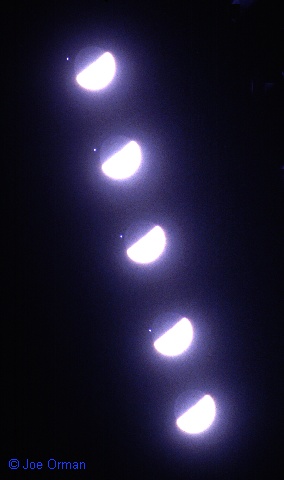Credit & Copyright: Joe Orman
Explanation:
On May 21, viewed from the continental US,
a star winked out as it passed behind the dark limb of the
first-quarter
Moon.
The star,
Regulus, is hotter than the sun, about 69 light-years distant,
and shines in Earth's skies as the
brightest star in the
constellation Leo, the Lion.
The Moon is the brightest object in
the night sky and
is less than 1.5 light-seconds away.
As illustrated in this multiple-exposure photograph, such
lunar occultations of bright stars can be majestic
to watch.
Their exact timing depends on the observer's location but
they are not particularly rare occurrences.
Astronomers can use lunar occultations to
help map the surface of
the Moon.
1999 2000 2001 2002 2003 2004 2005 2006 2007 2008 2009 2010 2011 2012 2013 2014 2015 2016 2017 2018 2019 2020 2021 2022 2023 2024 2025 |
Yanvar' Fevral' Mart Aprel' Mai Iyun' Iyul' Avgust Sentyabr' Oktyabr' Noyabr' Dekabr' |
NASA Web Site Statements, Warnings, and Disclaimers
NASA Official: Jay Norris. Specific rights apply.
A service of: LHEA at NASA / GSFC
& Michigan Tech. U.
|
Publikacii s klyuchevymi slovami:
Moon - occultation - regulus - pokrytiya zvezd - Regul - pokrytie
Publikacii so slovami: Moon - occultation - regulus - pokrytiya zvezd - Regul - pokrytie | |
Sm. takzhe:
Vse publikacii na tu zhe temu >> | |
